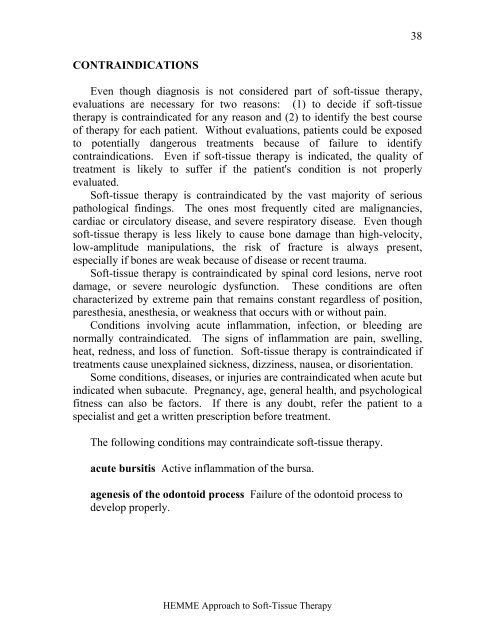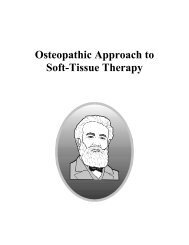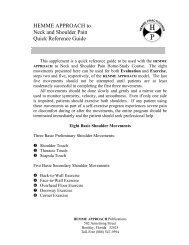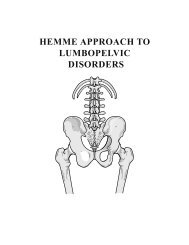HEMME APPROACH TO SOFT-TISSUE THERAPY
HEMME APPROACH TO SOFT-TISSUE THERAPY
HEMME APPROACH TO SOFT-TISSUE THERAPY
Create successful ePaper yourself
Turn your PDF publications into a flip-book with our unique Google optimized e-Paper software.
38<br />
CONTRAINDICATIONS<br />
Even though diagnosis is not considered part of soft-tissue therapy,<br />
evaluations are necessary for two reasons: (1) to decide if soft-tissue<br />
therapy is contraindicated for any reason and (2) to identify the best course<br />
of therapy for each patient. Without evaluations, patients could be exposed<br />
to potentially dangerous treatments because of failure to identify<br />
contraindications. Even if soft-tissue therapy is indicated, the quality of<br />
treatment is likely to suffer if the patient's condition is not properly<br />
evaluated.<br />
Soft-tissue therapy is contraindicated by the vast majority of serious<br />
pathological findings. The ones most frequently cited are malignancies,<br />
cardiac or circulatory disease, and severe respiratory disease. Even though<br />
soft-tissue therapy is less likely to cause bone damage than high-velocity,<br />
low-amplitude manipulations, the risk of fracture is always present,<br />
especially if bones are weak because of disease or recent trauma.<br />
Soft-tissue therapy is contraindicated by spinal cord lesions, nerve root<br />
damage, or severe neurologic dysfunction. These conditions are often<br />
characterized by extreme pain that remains constant regardless of position,<br />
paresthesia, anesthesia, or weakness that occurs with or without pain.<br />
Conditions involving acute inflammation, infection, or bleeding are<br />
normally contraindicated. The signs of inflammation are pain, swelling,<br />
heat, redness, and loss of function. Soft-tissue therapy is contraindicated if<br />
treatments cause unexplained sickness, dizziness, nausea, or disorientation.<br />
Some conditions, diseases, or injuries are contraindicated when acute but<br />
indicated when subacute. Pregnancy, age, general health, and psychological<br />
fitness can also be factors. If there is any doubt, refer the patient to a<br />
specialist and get a written prescription before treatment.<br />
The following conditions may contraindicate soft-tissue therapy.<br />
acute bursitis Active inflammation of the bursa.<br />
agenesis of the odontoid process Failure of the odontoid process to<br />
develop properly.<br />
<strong>HEMME</strong> Approach to Soft-Tissue Therapy









